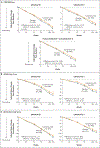Two Phase 3 Trials of Gantenerumab in Early Alzheimer's Disease
- PMID: 37966285
- PMCID: PMC10794000
- DOI: 10.1056/NEJMoa2304430
Two Phase 3 Trials of Gantenerumab in Early Alzheimer's Disease
Abstract
Background: Monoclonal antibodies that target amyloid-beta (Aβ) have the potential to slow cognitive and functional decline in persons with early Alzheimer's disease. Gantenerumab is a subcutaneously administered, fully human, anti-Aβ IgG1 monoclonal antibody with highest affinity for aggregated Aβ that has been tested for the treatment of Alzheimer's disease.
Methods: We conducted two phase 3 trials (GRADUATE I and II) involving participants 50 to 90 years of age with mild cognitive impairment or mild dementia due to Alzheimer's disease and evidence of amyloid plaques on positron-emission tomography (PET) or cerebrospinal fluid (CSF) testing. Participants were randomly assigned to receive gantenerumab or placebo every 2 weeks. The primary outcome was the change from baseline in the score on the Clinical Dementia Rating scale-Sum of Boxes (CDR-SB; range, 0 to 18, with higher scores indicating greater cognitive impairment) at week 116.
Results: A total of 985 and 980 participants were enrolled in the GRADUATE I and II trials, respectively. The baseline CDR-SB score was 3.7 in the GRADUATE I trial and 3.6 in the GRADUATE II trial. The change from baseline in the CDR-SB score at week 116 was 3.35 with gantenerumab and 3.65 with placebo in the GRADUATE I trial (difference, -0.31; 95% confidence interval [CI], -0.66 to 0.05; P = 0.10) and was 2.82 with gantenerumab and 3.01 with placebo in the GRADUATE II trial (difference, -0.19; 95% CI, -0.55 to 0.17; P = 0.30). At week 116, the difference in the amyloid level on PET between the gantenerumab group and the placebo group was -66.44 and -56.46 centiloids in the GRADUATE I and II trials, respectively, and amyloid-negative status was attained in 28.0% and 26.8% of the participants receiving gantenerumab in the two trials. Across both trials, participants receiving gantenerumab had lower CSF levels of phosphorylated tau 181 and higher levels of Aβ42 than those receiving placebo; the accumulation of aggregated tau on PET was similar in the two groups. Amyloid-related imaging abnormalities with edema (ARIA-E) occurred in 24.9% of the participants receiving gantenerumab, and symptomatic ARIA-E occurred in 5.0%.
Conclusions: Among persons with early Alzheimer's disease, the use of gantenerumab led to a lower amyloid plaque burden than placebo at 116 weeks but was not associated with slower clinical decline. (Funded by F. Hoffmann-La Roche; GRADUATE I and II ClinicalTrials.gov numbers, NCT03444870 and NCT03443973, respectively.).
Copyright © 2023 Massachusetts Medical Society.
Figures



Comment in
-
Gantenerumab in Early Alzheimer's Disease.N Engl J Med. 2024 Feb 29;390(9):866. doi: 10.1056/NEJMc2314291. N Engl J Med. 2024. PMID: 38416439 No abstract available.
-
Gantenerumab in Early Alzheimer's Disease. Reply.N Engl J Med. 2024 Feb 29;390(9):867. doi: 10.1056/NEJMc2314291. N Engl J Med. 2024. PMID: 38416440 No abstract available.
References
-
- van Dyck CH, Swanson CJ, Aisen P, et al. Lecanemab in early Alzheimer’s disease. N Engl J Med 2023; 388: 9–21. - PubMed
-
- Mintun MA, Lo AC, Duggan Evans C, et al. Donanemab in early Alzheimer’s disease. N Engl J Med 2021; 384: 1691–704. - PubMed
-
- Honig LS, Vellas B, Woodward M, et al. Trial of solanezumab for mild dementia due to Alzheimer’s disease. N Engl J Med 2018; 378:321–30. - PubMed
-
- Budd Haeberlein S, Aisen PS, Barkhof F, et al. Two randomized phase 3 studies of aducanumab in early Alzheimer’s disease. J Prev Alzheimers Dis 2022; 9: 197210. - PubMed
Publication types
MeSH terms
Substances
Associated data
Grants and funding
LinkOut - more resources
Full Text Sources
Other Literature Sources
Medical
